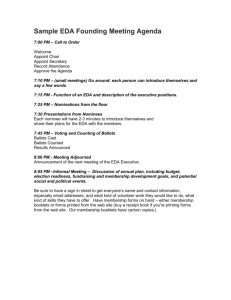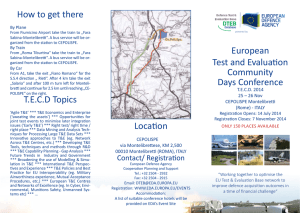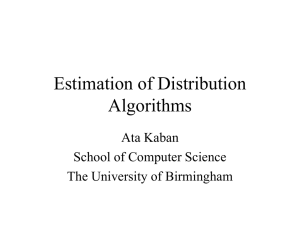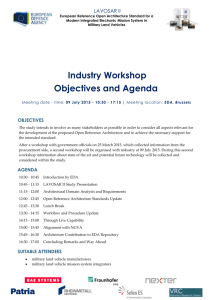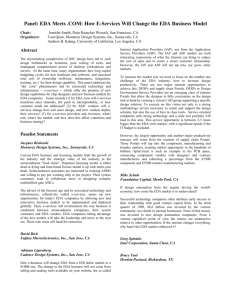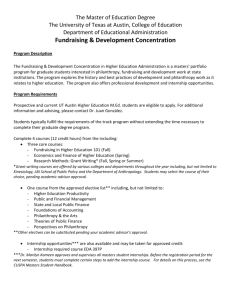CSE487 Data-intensive Computing Spring 2016
advertisement
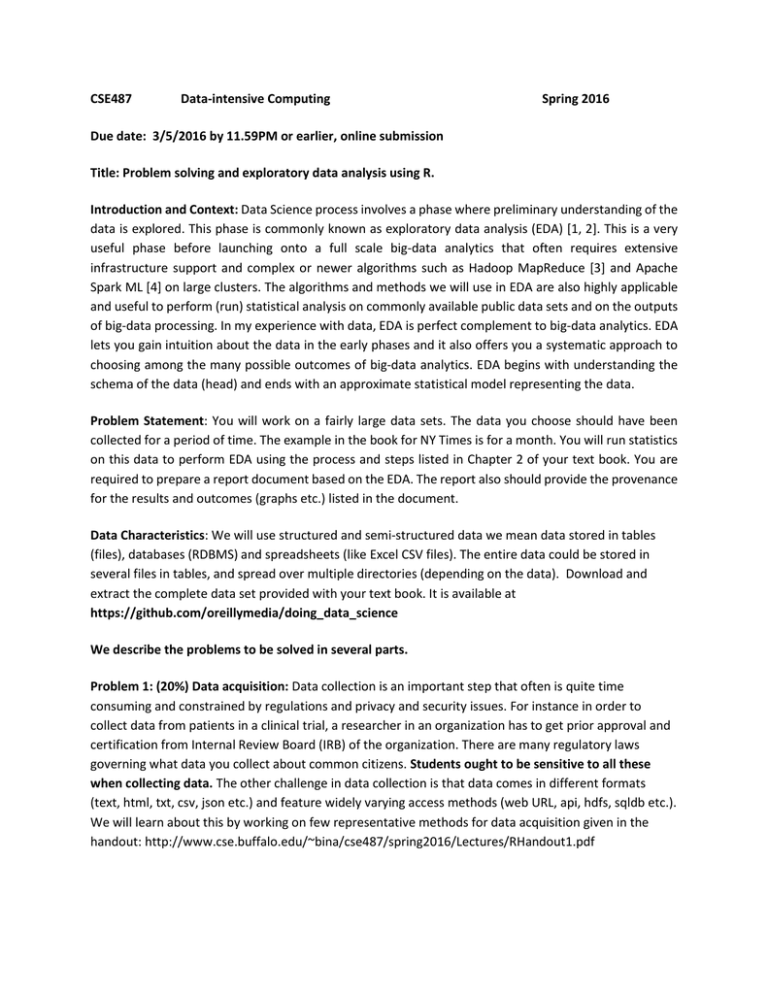
CSE487
Data-intensive Computing
Spring 2016
Due date: 3/5/2016 by 11.59PM or earlier, online submission
Title: Problem solving and exploratory data analysis using R.
Introduction and Context: Data Science process involves a phase where preliminary understanding of the
data is explored. This phase is commonly known as exploratory data analysis (EDA) [1, 2]. This is a very
useful phase before launching onto a full scale big-data analytics that often requires extensive
infrastructure support and complex or newer algorithms such as Hadoop MapReduce [3] and Apache
Spark ML [4] on large clusters. The algorithms and methods we will use in EDA are also highly applicable
and useful to perform (run) statistical analysis on commonly available public data sets and on the outputs
of big-data processing. In my experience with data, EDA is perfect complement to big-data analytics. EDA
lets you gain intuition about the data in the early phases and it also offers you a systematic approach to
choosing among the many possible outcomes of big-data analytics. EDA begins with understanding the
schema of the data (head) and ends with an approximate statistical model representing the data.
Problem Statement: You will work on a fairly large data sets. The data you choose should have been
collected for a period of time. The example in the book for NY Times is for a month. You will run statistics
on this data to perform EDA using the process and steps listed in Chapter 2 of your text book. You are
required to prepare a report document based on the EDA. The report also should provide the provenance
for the results and outcomes (graphs etc.) listed in the document.
Data Characteristics: We will use structured and semi-structured data we mean data stored in tables
(files), databases (RDBMS) and spreadsheets (like Excel CSV files). The entire data could be stored in
several files in tables, and spread over multiple directories (depending on the data). Download and
extract the complete data set provided with your text book. It is available at
https://github.com/oreillymedia/doing_data_science
We describe the problems to be solved in several parts.
Problem 1: (20%) Data acquisition: Data collection is an important step that often is quite time
consuming and constrained by regulations and privacy and security issues. For instance in order to
collect data from patients in a clinical trial, a researcher in an organization has to get prior approval and
certification from Internal Review Board (IRB) of the organization. There are many regulatory laws
governing what data you collect about common citizens. Students ought to be sensitive to all these
when collecting data. The other challenge in data collection is that data comes in different formats
(text, html, txt, csv, json etc.) and feature widely varying access methods (web URL, api, hdfs, sqldb etc.).
We will learn about this by working on few representative methods for data acquisition given in the
handout: http://www.cse.buffalo.edu/~bina/cse487/spring2016/Lectures/RHandout1.pdf
To that list of methods add an approach for reading json data. For example twitter data is published as
JSON objects.
Problem 2: Simple EDA (20%) This problem explores the effectiveness of online newspaper promotions
and advertisements. New York Times data collected in chapter 2 contains these information about
readers: {age, gender, number of impressions, number of clicks, and logged in or not.} The EDA process
from loading the data to plotting charts is explained in the sample code in pages 38-40. (a) Understand
these steps by executing the sample code on R and RStudio. Save the scripts, plots, and data
environments (for a possible TA demo). Name the R script NYTP2Username.R. (b) Now extend the EDA
to monthly data and follow the questions given in Page 38. Save the script as NYTP2ExUsername.R. (c)
For both problems save the charts and interpret the outcomes. Write a paragraph to interpret the
results. Save this in a single pdf document NYTP2Username.pdf. zip or tar and submit
NYTP2Username.tar
Problem 3: Data economy: A real case study (20%). For this problem you will work the RealDirect
problem discussed in Ch.2. Work on the sample code discussed in p.49,50. Then extend it to the entire
RealDirect data set to perform EDA to find some more insights. You will realize the data given as well as
the code require some cleaning and editing. This particular problem is a “data problem” from a
company is that is currently operational, see http://www.realdirect.com/ . Read the details and
understand the business model. The sample code is given in pages 49-50 for Brooklyn borough. Work on
it and make sure understand the EDA process. Then answer the questions in pages 48-49 in your report.
Repeat the analysis for different boroughs. Save the scripts, plots, matrix of plots to compare various
boroughs, and data environments (for a possible TA demo). (a) Name the R script RD3Username.R. (b)
Now extend the EDA to monthly data and work on the questions given in page 48-49. Save the script as
RDP3ExUsername.R. (c) For both problems save the charts and interpret the outcomes (charts): write a
paragraph to interpret the results. Save this in a single pdf document RDP3Username.pdf. zip and tar
and submit RDP3Username.tar
Problem 4: Statistical analysis to support new data product (20 %) In this problem we will further
explore the RealDirect business. You should realize by now RealDirect has built a business around
existing real estate (buying and selling) business by creatively repurposing the data and building a data
product around it. They have created a web (and mobile) portal with tools to facilitate real estate
related operations. Assume you have been hired by ReaDirect to extend the line of product offerings.
You put on your thinking cap and realize that NY is a prime location for apartment rental since buying
real estate (houses and apartments) is beyond their means for many. You also realize that many
prospective clients take to twitter when they need something and want to express their sentiments and
status. You plan to recommend to the executive team at RealDirect that they should offer apartment
rental as a product. You want to arm yourself with data to prove your recommendation. You plan to
collect twitter data about apartment rental and real estate (buying a house) for a week on a daily basis
and show the feasibility of your recommendation with this statistical analysis. Also provide a pricing
model (ex: subscription or one time registration etc.). Prepare the tar file as suggested in Problems 3
and 4 and submit the RDExP4UserName.tar
Problem 5: Stream processing (20%): Processing and analyzing streaming data is an important emerging
area. A stream is a (digitized) sequence of events. (Streaming applications are applications that are
deployed on demand: we will focus on that in Project 2.) Example of streams include sensor data, news
events and tweets). It is election season in the USA now, why not observe who is trending and do some
daily and weekly summarization. We will collect tweets from various regions of the country and plot the
daily and weekly trend and summarize the stats. These trends and summarization are to be displayed on
web /mobile portal created by R Shiny that is a web application framework for R. See
http://shiny.rstudio.com/ and study the examples. Shiny has a web client front end powered by R on the
server end. You can really create a very nice election dashboard with live streaming data. For inspiration
look at the examples of Shiny dashboards at http://shiny.rstudio.com/gallery/ . You can use data any
other domain too (Eg. Financial markets and stock data).
Implementation details:
1. You work on your own (group work is NOT allowed in this project.) You can source your data
from multiple sources while this is NOT a requirement. You may have to clean the data.
2. Now for the most critical aspect: What statistics will you run on the data collected? The statistics
discussed in Chapter 2 is quite basic and you should be able to run summaries, plots and pdfs as
discussed in Chapter 2. Perform these and make sure you record the outcome in your report.
3. Perform the analysis for a single data set (file). Extend it to multiple files/data sets. Visualize
some metrics and distribution over time. Describe all the outcomes in your report.
4. You are required to prepare a detailed report and documentation that will allow us to repeat
the experiment/analysis you have carried out and also provide the provenance for the results
you have generated.
5. Use elegant directory structure and naming conventions for directories and files to capture all
the work for project 1 and then tar or zip each problem into its own compressed file of selfexplaining names and problem# and username.
6. Submit the solutions as soon as you complete them. Do not wait till the last minute to work on
all the parts.
7. Recommended dates for completion of the parts proving the feasibility of the project
completion within the allocated time: 2/12, 2/14, 2/21, 2/28, 3/5
8. Do not publicize the code on github or any other similar public forum until the semester is
over.
References:
1.
2.
3.
4.
C. ONeil and R. Schutt. Doing Data Science. Orielly, 2013.
J. Tukey. Exploratory Data Analysis. Pearson, 1977.
Hadoop-mapreduce. http://hadoop.apache.org/, last viewed Jan 2016.
Spark ML, https://spark.apache.org/docs/1.2.1/ml-guide.html, last viewed Feb 2016.
